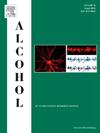Associations of physical pain, alcohol use, and related factors in the daily lives of patients with chronic low back pain
IF 2.9
4区 医学
Q3 PHARMACOLOGY & PHARMACY
引用次数: 0
Abstract
Background
Alcohol use and chronic pain are highly prevalent, costly, and have a bidirectional relationship. This may occur, in part, because of the analgesic effects of alcohol. Specifically, individuals may drink alcohol to address both physical pain and the subsequent increases in negative affect that may be brought on by painful experiences. The current project examined the Catastrophizing, Anxiety, Negative Urgency, and Expectancy (CANUE) model in daily life to better understand the association between alcohol use and pain.
Methods
Hypothesized paths of the CANUE model were examined using intensive longitudinal data (n = 34; total nobservations = 2960) collected using ecological momentary assessment over fourteen days from patients with chronic lower back pain who reported drinking alcohol (ndrinking episodes = 5.88). Multilevel models examined associations of pain, negative affect, and alcohol use, as well as potential moderators (pain-related cognitions, alcohol expectancies, and impulsivity) of these associations.
Results
Previous-occasion physical pain, but not cumulative-average pain, and pain-related alcohol expectancies, were associated with a greater likelihood of alcohol use. Though there was no main effect of cumulative-average negative affect on alcohol use, negative affect interacted with impulsivity, such that participants were more likely to continue drinking when experiencing increased negative affect and impulsivity. Results did not find a hypothesized indirect effect of pain on alcohol use via negative affect. Alcohol use was associated with reduced next-occasion pain and increased perceptions of alcohol-related pain relief.
Discussion
While cumulative-average pain was not associated with an increased likelihood of drinking, individuals were more likely to drink after occasions of elevated pain. This may indicate that participants drank to reduce pain, as was also suggested by the association between pain-related alcohol expectancies and drinking. This is one of the first studies to examine associations of alcohol use and chronic pain in daily life. The results provide evidence for the importance of pain as an antecedent to alcohol use. Findings supported some components of the CANUE model but also highlight the need for further investigation to inform potential revision of the mode.
慢性腰痛患者日常生活中躯体疼痛、酒精使用及相关因素的关联
背景:酒精使用和慢性疼痛是非常普遍的,昂贵的,并且有双向关系。这可能部分是由于酒精的镇痛作用。具体来说,个人喝酒可能是为了解决身体上的疼痛,以及随后由痛苦经历带来的负面影响的增加。目前的项目研究了日常生活中的灾难化、焦虑、消极紧迫性和期望(CANUE)模型,以更好地理解酒精使用与疼痛之间的关系。方法:使用密集的纵向数据检验CANUE模型的假设路径(n=34;从报告饮酒的慢性腰痛患者(未饮酒发作=5.88次)中使用生态瞬时评估收集了14天的总观察值= 2960。多层模型检验了疼痛、负面影响和酒精使用之间的关联,以及这些关联的潜在调节因子(疼痛相关认知、酒精预期和冲动性)。结果:以前的身体疼痛,但不是累积的平均疼痛,以及与疼痛相关的酒精预期,与更大的酒精使用可能性有关。虽然累积平均负面影响对酒精使用没有主要影响,但负面影响与冲动性相互作用,因此当参与者经历负面影响和冲动性增加时,他们更有可能继续饮酒。结果没有发现假设的疼痛通过负面影响对酒精使用的间接影响。饮酒与减少下一次疼痛和增加酒精相关疼痛缓解的感觉有关。讨论:虽然累积平均疼痛与饮酒的可能性增加无关,但个体在疼痛加剧的情况下更有可能饮酒。这可能表明参与者喝酒是为了减轻疼痛,正如与疼痛相关的酒精预期和饮酒之间的联系所表明的那样。这是研究日常生活中酒精使用与慢性疼痛之间关系的首批研究之一。研究结果为疼痛作为酒精使用前因的重要性提供了证据。研究结果支持CANUE模型的一些组成部分,但也强调了进一步调查的必要性,以便为该模型的潜在修订提供信息。
本文章由计算机程序翻译,如有差异,请以英文原文为准。
求助全文
约1分钟内获得全文
求助全文
来源期刊

Alcohol
医学-毒理学
CiteScore
4.60
自引率
4.30%
发文量
74
审稿时长
15.6 weeks
期刊介绍:
Alcohol is an international, peer-reviewed journal that is devoted to publishing multi-disciplinary biomedical research on all aspects of the actions or effects of alcohol on the nervous system or on other organ systems. Emphasis is given to studies into the causes and consequences of alcohol abuse and alcoholism, and biomedical aspects of diagnosis, etiology, treatment or prevention of alcohol-related health effects.
Intended for both research scientists and practicing clinicians, the journal publishes original research on the neurobiological, neurobehavioral, and pathophysiological processes associated with alcohol drinking, alcohol abuse, alcohol-seeking behavior, tolerance, dependence, withdrawal, protracted abstinence, and relapse. In addition, the journal reports studies on the effects alcohol on brain mechanisms of neuroplasticity over the life span, biological factors associated with adolescent alcohol abuse, pharmacotherapeutic strategies in the treatment of alcoholism, biological and biochemical markers of alcohol abuse and alcoholism, pathological effects of uncontrolled drinking, biomedical and molecular factors in the effects on liver, immune system, and other organ systems, and biomedical aspects of fetal alcohol spectrum disorder including mechanisms of damage, diagnosis and early detection, treatment, and prevention. Articles are published from all levels of biomedical inquiry, including the following: molecular and cellular studies of alcohol''s actions in vitro and in vivo; animal model studies of genetic, pharmacological, behavioral, developmental or pathophysiological aspects of alcohol; human studies of genetic, behavioral, cognitive, neuroimaging, or pathological aspects of alcohol drinking; clinical studies of diagnosis (including dual diagnosis), treatment, prevention, and epidemiology. The journal will publish 9 issues per year; the accepted abbreviation for Alcohol for bibliographic citation is Alcohol.
 求助内容:
求助内容: 应助结果提醒方式:
应助结果提醒方式:


